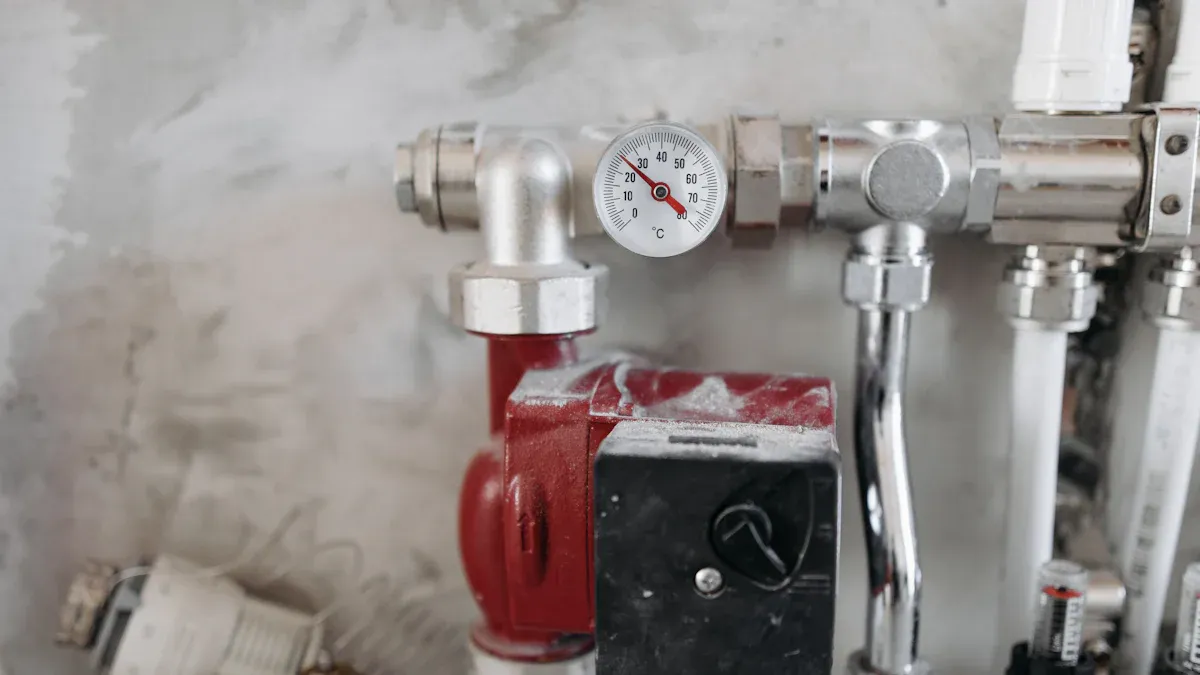Author:
-
Position:
General Manager of Foreign Trade Department, Taojun Refrigeration -
Professional Experience:
Engaged in international trade within the refrigeration industry since 2004.
Expert in brand strategy and omni-channel marketing, having led three multi-million yuan projects that boosted brand exposure by over 200%.
-
Core Competencies:
Proficient in data analysis and user growth strategies.
Skilled in SEO/SEM and social media management tools.
Experienced in cross-departmental collaboration and team leadership.
-
Philosophy:
"Data-driven decisions, creativity-powered branding." Committed to achieving business value and user experience excellence through refined operations. -
Vision:
Eager to collaborate with partners to explore emerging market opportunities and set industry benchmark cases.
Contact Us to Find More Products
Selecting a Filter Drier for Your Factory: What Every Engineer Should Know

Selecting the right Filter Drier protects factory refrigeration systems from moisture and contaminants. Engineers must consider the unit’s capacity and ensure compatibility with refrigerant types and operating conditions. Incorrect choices often cause system failures, lead to reduced efficiency, and result in costly downtime.
Key Takeaways
- Choose a filter drier that matches your system’s refrigerant and lubricant to prevent corrosion, sludge buildup, and system failures.
- Select a filter drier with the right moisture and contaminant removal capacity to keep your system efficient and avoid blockages or damage.
- Follow proper sizing, installation, and maintenance steps to ensure reliable operation, reduce energy use, and avoid costly downtime.
Filter Drier Selection Criteria

Refrigerant and Lubricant Compatibility
Selecting a filter drier that matches the system’s refrigerant and lubricant is essential for reliable operation. Incompatibility can trigger chemical reactions, leading to refrigerant decomposition and the formation of acids such as HCl and HF. These acids corrode metal surfaces and attack the desiccant’s molecular structure. When incompatible desiccants interact with POE lubricants, organic acids form, resulting in sludge deposits that clog expansion devices and cause blockages. The consequences include:
- Acid formation and corrosion of internal components
- Sludge buildup leading to blockages and mechanical failures
- Lubrication failure, which can result in compressor breakdown
- Reduced system efficiency and eventual system failure
Engineers should always consult manufacturer datasheets to verify compatibility with both refrigerant and lubricant. This step prevents costly downtime and extends equipment life.
Moisture and Contaminant Removal Capacity
A filter drier must effectively remove both moisture and contaminants to protect the system. Industry standards such as ISO 8573.1 and ISO 12500 define the requirements for moisture, oil, and particulate removal. For example, achieving a -40°F pressure dew point is critical in food processing to prevent bacterial growth. Inadequate removal of moisture and contaminants can cause:
- Clogged filters and internal parts, reducing airflow and efficiency
- Mold and mildew growth, degrading air quality
- Overheating and mechanical failures in compressors and motors
- Increased noise, odors, and uneven temperature distribution
| Aspect | Standard Reference | Key Details & Requirements |
|---|---|---|
| Moisture Removal | ISO 8573.1 Class 2 | Desiccant dryers must achieve -40°F/-40°C pressure dew point |
| Particulate Removal Efficiency | ISO 12500-3 | 1.0 micron filters recommended for Class 2 solid particulate removal |
| Oil Vapor Removal | ISO 12500-2 | Adsorption capacity measured in mg of adsorbed vapor |
Regular maintenance, including filter replacement and coil cleaning, helps maintain system efficiency and longevity.
Filtration Efficiency and Pressure Drop
High-quality filter driers in industrial applications often achieve filtration efficiency ratings of 99.9% for particles down to 20 microns. This performance results from advanced multi-layer fiberglass filters. However, filtration efficiency must balance with pressure drop. Excessive pressure drop forces compressors to work harder, increasing energy consumption and reducing system efficiency. Over time, clogging from moisture and debris can further increase pressure drop. To maintain optimal performance:
- Select filter driers with low-pressure drop designs
- Monitor pressure drop regularly and replace clogged units promptly
- Ensure moderate airflow rates to prevent excessive compressor strain
Tip: A low-pressure-drop filter drier can restore temperature stability and reduce energy use, as demonstrated in cold chain facilities.
Sizing and Installation Considerations
Proper sizing ensures the filter drier can handle the system’s refrigerant flow and contaminant load. System capacity, refrigerant type, and operating conditions all influence sizing decisions. Larger systems or those operating in humid or dusty environments may require larger or specialized filter driers. Manufacturers provide sizing charts based on system tonnage and refrigerant type. Installation best practices include:
- Placing the filter drier in the correct position to prevent desiccant displacement
- Using models with Molecular Sieve desiccants for superior moisture absorption
- Replacing the filter drier whenever the system is opened or reoperated
- Following staged filtration approaches for compressed air systems
| Filter Drier Type | Refrigerant Compatibility | Max Working Pressure (bar) | Application |
|---|---|---|---|
| DMLE/DCLE | HFCs, mineral/benzene oils | 50 | General refrigeration and A/C |
| DMT | Transcritical CO2 (R744) | 140 | High-pressure CO2 systems |
| DCR (replaceable) | CO2 systems | N/A | Liquid/suction lines in CO2 systems |
Quality, Brand, and Additional Features
Selecting a reputable brand ensures consistent quality and access to technical support. Modern filter driers offer features that enhance reliability and ease of maintenance:
- Unique cartridge designs for quick servicing and reduced downtime
- No welded joints to minimize leak points
- Lightweight construction for easier handling
- High flow rates for efficient operation
- Compatibility with high-pressure refrigerants like R744 (CO2)
- Drain plugs for easy removal of trapped liquid
Recent advancements include smart diagnostics, IoT integration for real-time monitoring, and eco-friendly materials. These features improve system reliability, support regulatory compliance, and reduce total cost of ownership.
Note: Manufacturer datasheets provide critical information on operating pressure, temperature range, and filtration size. Always review these documents before final selection.
Practical Filter Drier Selection Steps

Step-by-Step Selection Checklist
Engineers can streamline the filter drier selection process by following a clear checklist. This approach ensures the system operates efficiently and avoids costly errors.
- Identify the refrigerant and lubricant used in the system.
- Determine the required moisture and contaminant removal capacity based on application standards.
- Calculate the correct size using manufacturer charts and system specifications.
- Evaluate filtration efficiency and acceptable pressure drop for the application.
- Review installation requirements, including flow direction and space constraints.
- Assess quality, brand reputation, and any additional features such as built-in indicators.
- Consult technical resources for support:
- Engineering services and project management support
- Design questionnaires to specify requirements
- Technical support for expert guidance
- Access to a comprehensive knowledge base
- Filtration and drying testing services
- Integrated filtration and drying systems
- Resource libraries and social media centers for updates
Timely replacement and proper maintenance of filter driers prevent restricted refrigerant flow, pressure imbalances, and compressor failure. These steps protect against costly repairs and unplanned downtime.
Common Mistakes to Avoid
Many engineers encounter recurring pitfalls during filter drier selection and installation. The table below highlights frequent mistakes, their consequences, and recommended solutions.
| Mistake | Explanation | Consequences | Solution |
|---|---|---|---|
| Installing the filter drier in the wrong direction | Most filter driers are uni-directional; incorrect installation prevents filtration | No moisture removal, contamination escapes, pressure drops | Follow the flow direction label on the drier |
| Choosing the wrong model/size | Line size alone is insufficient; incorrect sizing affects performance | Small drier fails to filter/dry; oversized causes pressure drop | Consult manufacturer catalog and technical support |
| Brazing installation errors | Not protecting joints or bleeding nitrogen | Rust, leaks, scaling, oxidation | Protect joints; bleed nitrogen during brazing |
| Incorrect torque on threaded joints | Using improper torque | Leaks or thread damage | Follow manufacturer torque specifications |
| Avoiding installation of sight glass/moisture indicators | Skipping indicators to save cost | No direct way to monitor drier health | Always install a sight glass or use driers with built-in indicators |
Blockages from unfiltered particles reduce heat transfer efficiency and can cause severe compressor damage. Engineers should always verify installation and maintenance procedures to avoid system failure.
Engineers should always prioritize compatibility and capacity when selecting a filter drier. Proper selection and maintenance protect internal components, improve reliability, and reduce maintenance costs. Consulting technical professionals for complex systems ensures optimal performance.
A systematic approach helps avoid costly mistakes and safeguards long-term factory investments.
FAQ
What signs indicate a filter drier needs replacement?
A pressure drop across the filter drier, frost buildup, or visible moisture in the sight glass signals the need for immediate replacement.
Can engineers use any filter drier with all refrigerants?
No. Each filter drier matches specific refrigerants and lubricants. Using the wrong type can cause chemical reactions and system damage.
How often should a factory replace filter driers?
Most manufacturers recommend replacement during major service, after system opening, or when pressure drop exceeds specifications. Regular inspection ensures optimal performance.








